How to Trim Your Mustache Like a Pro in 7 Easy, Illustrated Steps
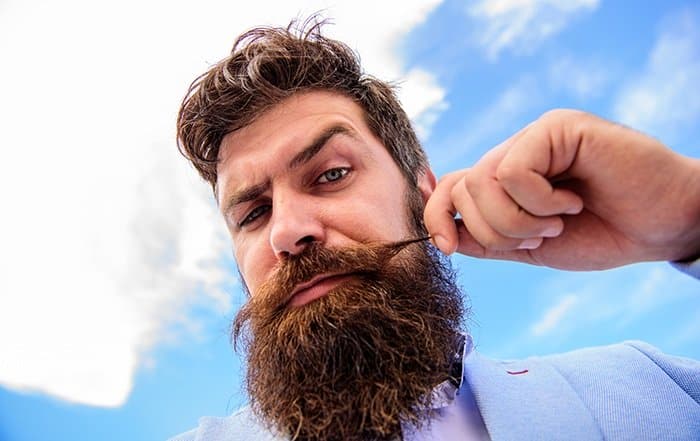
Somewhere along the line, the mustache lost its way.
Or, perhaps more specifically, it got pushed out of favor by fashion trends that scoffed at mustachioed men: “Wait … you want to look like a 1970s porn star?”
Well, the mustache has made a comeback and is no longer the source of creepy vibes – at least not from men who actually take the time to groom their mustache and take care of it..
We think that mustaches are a’s a nice trend, but we also want to remind you that, as with a beard, proper mustache maintenance is the difference between a cheesy-looking ‘stache and one that rocks your world and the world of those around you.
So, let’s talk about how to trim a mustache to ensure that the cheese factor always remains low.
You won’t look like a retro adult film star – let your chest hair grow into a forest if that’s the image you desire – but you’ll look up-to-date and, frankly, pretty damn good.
1. The first step? Let it grow!
OK, even as obvious as it seems, you need to grow a mustache before you can trim it. That’s hardly a news flash. However, you need to let it grow until it’s either full and thick or well on its way to getting there.
And that leads to an obvious question: “How long will it take before it’s thick enough for trimming?” The general answer is two to four weeks, but, again, that’s doesn’t apply to all men because the rate at which men grow facial hair varies from individual to individual.
The guy who lives next door or who works in the next cubicle may sport a Tom Selleck-like mustache after only a couple of weeks of growth, while yours may look as if you forgot to wipe clean the area above your upper lip.
While your genetics play the most significant role in determining the rate at which your facial hair grows, others things can have a hand in it, as well. Many studies show that lifestyle choices, such as diet, exercise, rest, and smoking impact hair growth.
For instance, a consistent exercise routine that includes aerobic workouts improves your blood circulation, and good circulation helps nutrients reach hair follicles in a more efficient, faster way.
Exercise is also a great way to reduce stress, and as both physical and mental stress can harm your immune system and limit your body’s basic functions – including your ability to grow facial hair.
Your diet should be rich in essential vitamins and nutrients, not the least of which are B-complex vitamins.
Biotin, or vitamin B7, is one of the most important vitamins for growing facial hair, while vitamins A, C, and E also help establish the proper conditions for successful hair growth.
2. Choose a beard or mustache style to try
The right beard style can make a huge difference in the way you look. It is the difference between looking like someone slapped a patch of hair on your face, and actually rocking your mustache. There are many styles of beards out there to try, but not all of these will work for you.
So, It is important to choose a good beard style early on so you can get to work on shaping your beard to grow the desired style right from the start. It will be much easier and quicker to grow the perfect beard and mustache if you already have the right style in mind.
Here is a quick look at some of the top things that might influence the beard style that you should wear.
Your natural hair growth
Some men’s beards grow fast while others are quite slow to reach a good length. Some men grow full, lush beards that reach all the way from their cheekbones down to their neckline. Other men don’t have quite such a huge growth area. For some men, their beards grow thick and dense while others have a more patchy beard.
Choosing a beard style that works with your natural growth can help you achieve a great look much quicker. Not all beard styles will be possible for your natural facial hair. Men with a very low beard line need to consider beard and mustache styles like goatees, extended goatees, Balbo’s, or Verdi’s unless they want to consider hair follicle grafting.
Men with fuller beards can try just about any type of beard style, but might get tired of all the shaving required for thinner beard styles like goatees, anchors, or other low-cut beard styles.
Your face shape
Some beard styles might also suit your face shape better than others. A bushy beard style like long-goatees is ideal for hiding a double chin or for hiding a weak jawline. These beard styles can mean a huge upgrade for men with this feature. These beard styles can also make men with a prominent chin, diamond, heart, or triangle face shapes look a bit shady or old.
Your age
A beard and mustache style can place you in a whole different age and style category. Mustaches like the imperial, for example, aren’t very common with younger men. Long bushy beards can make you look a bit older than you actually are, while a trimmed and groomed beard can make you seem a lot younger.
Your work and lifestyle
Some beard shapes require a lot more grooming than others. Men who work in messy areas like mines often have a tough time keeping large full beards nice and clean. Facial hair can feel hot and sweaty in tropical climates. Your lifestyle might be so hectic that there might not be time to continuously trim and maintain a short style like the zorro or anchor.
Your skin
Your skin can also affect the type of beard you can wear. Men with extremely sensitive skin can’t shave too often, or they can start to struggle with razor burn, irritation, and ingrown hairs. A fuller beard or stubble is much more ideal in this case because you will have a tough time maintaining a groomed and shaped beard. Those with less sensitive skin might find it much easier to maintain beards or mustaches that require more grooming.
3. How to prepare for your mustache trim
You’ve grown your mustache until it’s nice and thick. Now it’s time to get serious about trimming it. You’ve probably heard the time-worn phrase, “Prior preparation prevents poor performance,” or a variation thereof, and it certainly applies to trimming facial hair.
That said, make sure you have all of your tools in place – beard comb, scissors or beard and mustache trimmer (or both, if you prefer), and of course, a mirror, because you need to see what you’re doing..
You’ll also want to do your trimming in a well-lighted area, such as your bathroom, and preferably over a sink, towel, or waste bin, or anything that’s appropriate for catching your newly-snipped mustache hair.
It doesn’t hurt to wash your mustache before trimming, either. You’ll not only rid your mustache of dirt and debris (and maybe some of yesterday’s lunch, too), but you’ll also soften its hairs to make them easier to cut. Washing in warm water opens up your follicles, and softens your skin to help you avoid razor burn.
Many men choose between a multi-use mustache and beard or scissors for the actual trimming process.
It all depends on what you’re most comfortable with, but if you’re new to facial hair trimming, you may want to use scissors for their first few trims because you’ll reduce the risk of cutting off more than you intend.
Getting Started – What’s the right way to trim your mustache?
Technically, there isn’t a right or wrong way to trim your mustache (aside from hacking it up like someone who doesn’t give a crap about how they look) because a lot depends on your preferred mustache style and how thick your hair is when you finally get down to business.
Furthermore, some men require only a small bit of trimming to keep their mustache looking its best, while others – especially you men with thicker patches of hair above your lip – may need more maintenance.
But, unless you’re aiming for a specific style, such as the walrus mustache, it’s not a great look when your mustache droops below your upper lip.
Not only doesn’t it look good, but you also have to deal with those drooping hairs when you’re putting food in your mouth. Your female friend wouldn’t also enjoy having your mustache hair in her way every time she leans in for a kiss.
So, if nothing else, it’s a good idea to trim those hairs that hang over your mouth like stalactites, whether you use a trimmer or a pair of scissors.
On the other hand, you must also be careful not to trim those droopers to excess because you’ll end up with a large gap between your mustache and upper lip that looks, well, ridiculous. You don’t want to go round looking like Cleveland Brown from Family Guy now, would you?
You’re also trimming your mustache’s thickness, and, for most men, that means keeping some of its bulk while also giving it some shape.
A trimmer may work best for dealing with thickness, but, again, you may prefer scissors, especially if you’re particularly adept at using them. The job will take a bit longer with scissors, however.
We’ll talk more about reducing your mustache’s volume in a bit.
4. Preparing your mustache by combing it
The first thing you should take before the trimming process begins is to comb your mustache.
Combing makes your trim job easier because, for one, it helps to straighten mustache hairs to make them easier to cut. Comb downward toward your lip to help locate wiry stray hairs and split ends that need trimming.
Combing, in short, allows you to see the length of your hairs clearly.
A brief word about mustache and beard combs before we move on to the next step: the quality of your comb matters. And, as obvious as it sounds, choosing a comb designed for the job, i.e., a mustache comb, makes it much easier to find a quality comb.
Never, on the other hand, use a comb that you just got for a bargain-basement price at your local drugstore or mini-mart – especially those made of plastic.
Those combs are the “junk food” of grooming devices in that they serve a similar function as other combs, but don’t do your (mustache’s) overall health any good at all.
Before you buy a mustache comb then, fellas, keep these things in mind:
- What is its teeth width?
Teeth width is ultra important for mustache and beard combs (which are often one and the same). You need wider teeth – wider than on regular hair combs – because the hair on your face is thicker and coarser than the hair on your scalp.
If the comb’s teeth width is too narrow, you’ll struggle to pull it through your mustache hair.
- What’s it made of?
Forget plastic. You need a mustache and beard comb that’s made of, preferably, wood.
The top-quality facial hair combs come with various teeth widths and are hand-cut – not stamped cut like mass-manufactured combs – which means you’ll avoid the tugging and snagging you’ll get with lesser combs.
Combs made from cellulose acetate (which is rubber-like) are also a potentially good choice).
- How’s it made?
We’ve mentioned that hand-cut combs are the best because their teeth are individually cut and then polished, which is the primary reason why they don’t have the jagged edges of mass-produced combs.
Your mustache and beard will thank you for buying a hand-cut comb.
5. Your first trimming maneuver is to cut across your upper lip
Start your trimming project by cutting the hairs closest to your upper lip with scissors or a trimmer. Follow the line of your upper lip and make small cuts.
How much you cut is up to you, but don’t leave too much of a gap. If you’re using a trimmer, press it – gently – to the top of your lip and pull it away to make the cut.
Your best bet when trimming the upper lip is to start at the outside edges of your mustache and work your way to the center. Once you’ve finished half of the mustache, start at the outside of the other half and work your way to the middle.
6. The next step: Trimming the upper areas of your mustache
After you’ve trimmed and neatened the area directly above your upper lip, it’s time to move on to the upper boundary of your mustache. Again, it’s your choice – a trimmer or scissors – but take your time. Here are some points to remember:
- Trim the area just below your nose, so it doesn’t look like your mustache is an extension of your nose hair. Not a good look.
- You can cut the top of your ‘stache at a 45-degree angle toward your lips to help give it a fuller appearance.
- The shape of your mustache depends on personal preference and the style you choose.
7. Don’t forget to get rid of your mustache’s ‘Bulk’
There’s a fine line between a mustache that’s overly bushy and one that’s so thin that a person across the room may not realize that you’re mustachioed.
Be careful of tripping over the fine line while reducing your mustache’s thickness and density; there’s really no right or wrong thickness, although too much is too much and too little is too little, if that makes sense.
We recommend reducing your mustache’s thickness by using a comb and scissors. Comb upward and away from your mustache so that the ends of its hairs extend just past the comb’s teeth. Then trim any excess hair with your scissors to help thin out your mustache.
Note: You can also use a trimmer to reduce your mustache’s thickness, and some even come with guides and settings that eliminate the need for using a comb. But be careful not to apply too much pressure with your trimmer and trim with its longer settings at the start.
You know the rule: you can always cut more, but you can’t replace what’s missing if you cut too much. Trim only a small bit at a time when thinning your mustache. Again, take your time, and don’t overdo it.
Run your comb through your mustache once you’re finished to see if any stray or unruly hairs remain. Use your scissors to cut those to your desired length.
8. Styling your ‘Stache: Have a plan before you get started
There are too many mustache styles – and methods for styling them – to list here, but if you’re like many men, you may want to experiment a little bit. The best advice we can give is to do your research and read up on a particular style that catches your eye.
The natural thickness of your mustache may determine if you can wear a certain style or not.
Also, remember that certain styles require minimal trimming while others take more careful shaping (like the handlebar, for instance). Find a style you like and then decide if you’re willing to take the time needed to shape it correctly.
Some mustaches may require mustache wax-like, again, the handlebar – while many don’t need any product at all. But no matter what style you choose, it won’t take long to master the art of shaping it. A good beard balm or beard oil can help maintain some of the frizz if you are going for a groomed look.
The Importance of choosing the right tools for trimming your mustache
Trimming your mustache is not unlike undertaking a do-it-yourself home improvement project in that you need the right tools to do the job correctly.
That said, your facial hair toolkit should include a trimmer that’s suitable for mustache styling and trimming.
In most cases, that means purchasing a multi-functional trimmer that’s suitable for both mustache and beard trimming, such as the Philips Norelco Multi-Groomer MG7750/49 that includes 23 separate grooming pieces.
There are several features and considerations to keep in mind as you’re choosing a trimmer, including blade quality, versatility, cord or cordless, the design, and price.
Blade quality
Your trimmer is only as good as its blades, and blade quality sets most quality trimmers apart from others. Stainless steel blades are a great option because they’re sharp yet safe, and won’t rust. They’re also good for sensitive skin.
Versatility
As mentioned, most mustache trimmers are part of multi-functional grooming machines capable of handling a variety of tasks, including beard and body grooming.
You’ll save money in the long run by buying a quality trimmer that works on your mustache, beard, eyebrows, sideburns, body – you name it.
Cord or cordless
Another thing to consider when buying a trimmer is whether it comes with a power cord or runs on batteries (or, in some cases, both).
The advantage of owning a cordless trimmer is its portability, but you also must be aware of its battery time and how often you need to charge it.
If you buy a corded version, check the cord’s length because it affects your maneuverability as you shave, which is important to many men.
Design
Trimmers are available in a multitude of designs, to say the least. Some have all the bells and whistles (and typically cost more), while others are sparser. It all comes down to how much you want and need.
Price
You’ll also find trimmers in a variety of price ranges, and it depends on your budget and what you expect from your trimmer. Prices also vary according to whether you purchase your trimmer online or at a store.
Scissors: Another vital tool for trimming your mustache
Trimmers are good. Trimmers are useful. But sometimes it all comes down to a pair of scissors.
Trimming scissors can make all the difference in maintaining and styling a mustache that looks great and one that looks no better than average – or worse.
Not just any scissors, however, at least not the kind you can buy cheaply at your local pharmacy or supermarket, but a pair of well-made professional scissors.
A pair of scissors we like and think you’ll like is the Professional Moustache Scissors. Made of the finest Japanese steel, these scissors are sharp and provide a precise, clean cut.
Why it’s important to use a mustache comb during the trimming process
A proper mustache care routine includes a quality mustache comb.
Like trimmers, many grooming combs are effective for use on mustaches and beards but, versatility notwithstanding, they serve the important function of helping you to train and shape your mustache once it’s reached full growth.
The latter is important because the chances are good that your mustache hairs will grow in unexpected patterns. Without a comb to guide them into the shape you want, your new ‘stache is going to look a bit haggard.
There are many quality mustache and beard combs available, such as the Kent Limited Edition Folding Beard & Mustache Comb, but we recommend buying one made of wood, and that’s, hopefully, handmade.
Whatever you do, resist the temptation to buy a cheap plastic comb that you might also use on your scalp hair. It is neither good for your mustache or your hair.
Don’t forget a mirror if you want the best trim
Unless you completely trust your sense of touch and feel, you’ll need a mirror during the mustache-trimming process.
Blindly undertaking the task leaves you open to far too many mishaps, like cutting off more than you wanted. Mistakes like those can quickly lead you down the dark road of, “I’ll just shave off the damn thing!”
There’s no need to shave off the damn thing, gents.
Conclusion
How about you? What kind of mustache trimming routine do you follow or recommend? What trimming tools are important to your routine? As always, we’d love to hear from you and welcome your comments and suggestions.

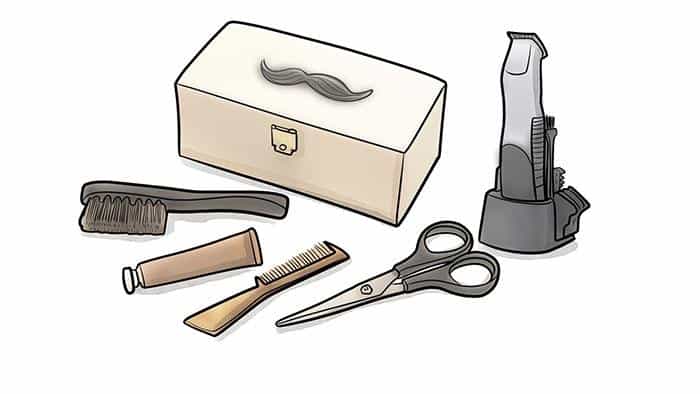
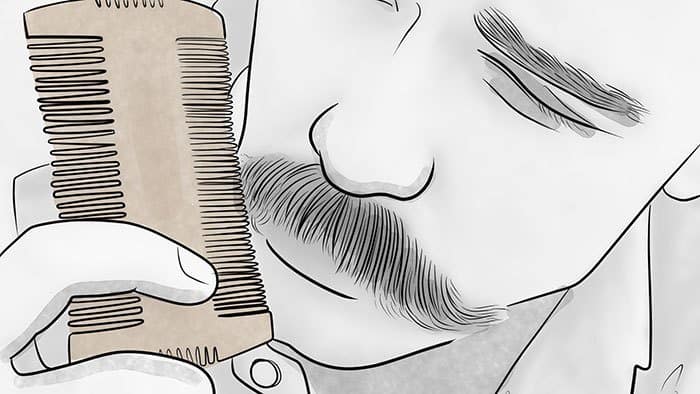

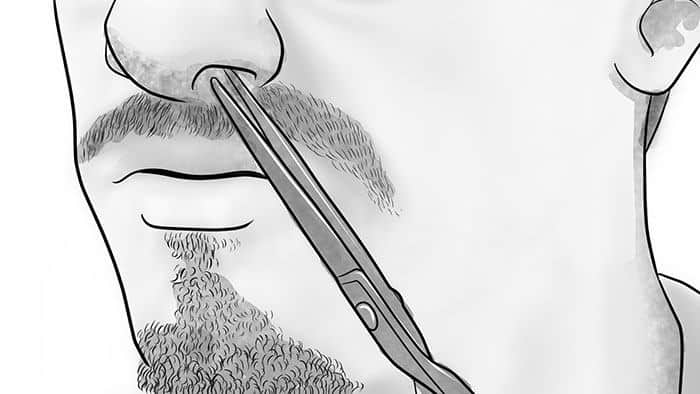
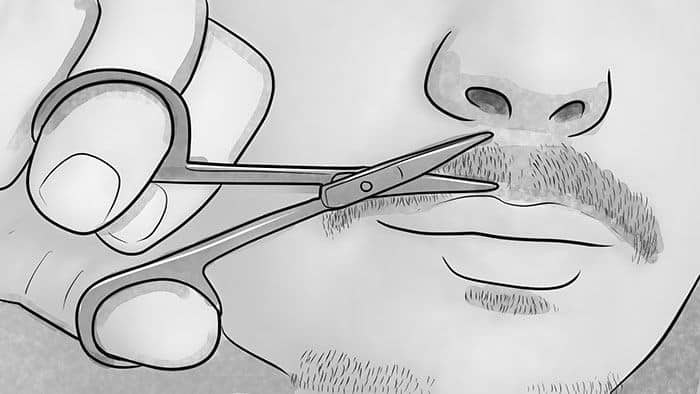
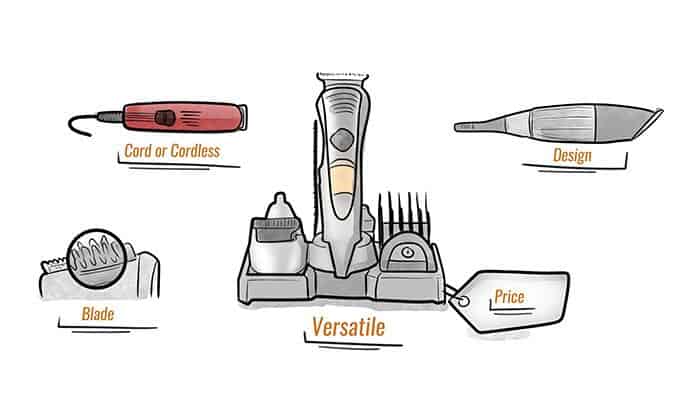
2 Comments
Great article! This has truly been really helpful. Thank you very much for sharing.
WOW! I think I would never make a mistake trimming my mustache ever again, Thanks for sharing the detail description, I think is one its kind! 🙂